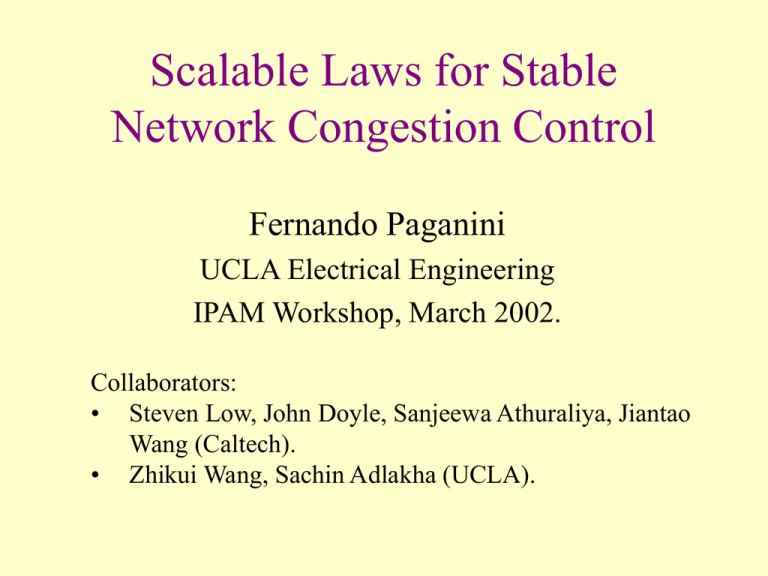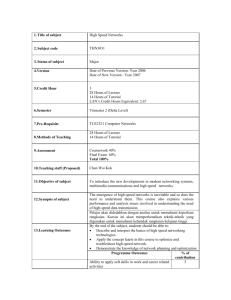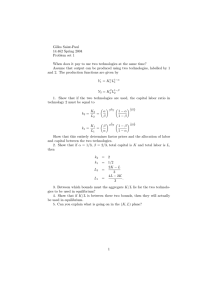Scalable Laws for Stable Network Congestion Control Fernando Paganini UCLA Electrical Engineering
advertisement

Scalable Laws for Stable
Network Congestion Control
Fernando Paganini
UCLA Electrical Engineering
IPAM Workshop, March 2002.
Collaborators:
• Steven Low, John Doyle, Sanjeewa Athuraliya, Jiantao
Wang (Caltech).
• Zhikui Wang, Sachin Adlakha (UCLA).
Outline
1. Introduction. Congestion control, models based
on prices.
2. Control objectives and linearized design. Local
stability theorem.
3. Global, nonlinear implementation. Alternatives
to improve fairness.
4. Packet level implementation in ns-2. Results.
5. Conclusions.
Congestion Control Problem
End systems
Routers
Links
• Regulate transmission rates of end-to-end connections so that
they take advantage of the available bandwidth, but avoid
exceeding it (congestion).
• Motivation:
– An interesting, large-scale feedback control problem.
– Deficiencies of current TCP (long queues, oscillations).
• Aim: regulate large “elephant” flows to a stable point that
exploits available capacity, but keep queues small so that
uncontrolled “mice” can fly through with minimal delay.
Fluid flow modeling
L communication links shared by S source-destination pairs.
Routing matrix:
i 1
1 if link l uses source i
Rli
0 otherwise
xi : Rate of i th source
yl : Total rate of l th link
cl : Capacity of the l th link
Rx y
1
2
i 3
i2
3
i4
1 1 0 0
R 0 0 1 0
Feedback mechanism:
0 1 1 1
Each link has a congestion measure or price pl .
Each source has access to aggregate price qi of the links in its path.
q RT p
Congestion Control Loop
x : source rates
ROUTING
R
y : aggregate
link flows
LINKS
SOURCES
q: aggregate prices
R
T
p : link prices
per source
Decentralized control at links and sources.
Routing assuming fixed, i.e. varying at much slower time-scale.
Optimization interpretation
(Kelly et al, Low et al, Srikant et al.,…)
An equilibrium point x0 , y0 , p0 , q0 can be interpreted as solving
max x U i ( xi ) ,
i
SOURCE
UTILITY
FUNCTION
subject to
Rx c
LINK CAPACITY
CONSTRAINTS
Equilibrium link price signals p0 provide either a barrier
function term, or a Lagrange multiplier for the constraint.
Remark: assuming only:
Equilibrium rate x0 is decreasing in the aggregate price q0 .
For each link, either y0l cl or p0l 0.
Then the equilibrium, if achieved, is always the optimum for
some utility function, p0 being the Lagrange multipliers.
“Primal”, “dual”, and the end-to-end principle.
x : source rates
R
ROUTING
y: aggregate
link flows
LINKS
SOURCES
q: aggregate prices
per source
RT
p: link prices
Usual convention (Kelly, Maulloo, Tan ’98):
primal = dynamics at sources, dual = dynamics at links.
It may appear that primal is closer to current TCP, and the
end-to-end principle. However:
• Current TCP has dynamics in both places.
• End-to-end principle is about complexity, not dynamics.
Dynamics and the role of delay
• Without delay, nothing would stop us from
adapting the sources’ rates arbitrarily fast.
• In the presence of delay, there is a stability
problem: e.g., controlling temperature of your
shower.
• Special case of general principle in feedback
systems: what limits the performance (e.g. speed
of response) are characteristics of the open loop
(bandwidth, delay).
• In this case, the only impediment is delay. In
particular, this sets the time-scale of our response.
Congestion control loop with delays
if,l s
e
Routing/
R f ( s)
li
Delay matrix:
0
x : source rates
R f ( s)
if source i uses link l .
otherwise
yl (t ) xi (t i f,l )
il
y : aggregate
flows per link
SOURCES
LINKS
Rb ( s )
q : aggregate prices
p: link congestion
measures or “prices”
per source
qi (t ) pl (t )
il
T
b
i ,l
RTT:
i
f
i ,l
b
i ,l
Control objectives and design
1. Track available capacity, yet almost empty queues.
2. Stability in the presence of large variations in delay.
3. Dynamic performance: respond as quickly as possible.
•
Difficulties for control synthesis:
–
–
–
–
•
Large-scale, coupled dynamics but decentralized information at
links and sources. Decentralized control design is hard.
Not just global variables, but the plant (routing, capacities,… )
changes in a way unknown to sources/links. Must be robust.
Delay can vary widely. However, sources can adapt to it.
To top it off, solution must be simple.
Our approach:
–
–
–
–
Local linear design with classical heuristics.
Validated analytically by a local multivariable stability proof.
Global nonlinear laws built from the linearization.
Performance verified empirically.
Matching capacity through integral control
Tracking of capacity requires integral action in the loop.
Where should we put integrators? A first look (ignore delay):
1. At the sources.
2. At the links.
c
c
x
y
x
y
R
R
k
s
I
I
q
RT
p
k I
q
x kR T Rx c
I
s
R
T
p
p ( R( k ) R T p c
Modes at k eig ( R R )
T
Modes at k eig ( RRT )
has more rows than columns. So
Now R
the first case has many additional modes at 0 unstable.
Compensation for delay
Include integrators at the links, pl l ( yl cl ).
Consider a static source rate control xi f i ( qi ), (f i decreasing).
Laws become a special case of those in Low and Lapsley '99.
Linearization around equilibrium as xi K qi . For a
e s
single link/source, the loop transfer function is L( s) K
s
2K
f s
e
K
1
e
b
s
s
Stable if K
. Sources
2
know RTT, so pick K , with < .
2
Stable for all delays.
Nyquist plot
of L( j )
Distributed gain compensation
In the multiple source case, we need to bound the
overall gain without access to global information.
One solution denotes increments around equilibrium :
xi
i x0i
qi
i
R f ( s)
il
1
p y
c
SOURCES
qi (t ) p (t ib )
y (t ) xi (t i f )
SINGLE
LINK
Rb ( s )T
1
i x0i i s
Loop transfer function: L( s )
e
cs i i
Nyquist argument for stability
i j
i x0i e
L( j )
c i j
i
x0i
Since
1, the loop gain is a convex combination of points
c j
i
e
in the curve
, scaled by i For i , no encirclements.
j
2
1
2
Note: if all delays are
scaled by some constant,
the plot does not change.
In the time domain, only
effect is a change in
time-scale of response.
Extension to arbitrary networks
Local analysis around equilibrium. Routing matrices refer
here only to bottleneck links.
x
xi
i
0i
M i
qi M i : bound on number of bottlenecks in
x : source rates
source i ’s path
R f ( s)
y R f ( s ) x
y : aggregate
flows per link
SOURCES
q : aggregate prices
per source
q RbT ( s ) p
LINKS
Rb ( s )
T
p: link prices
1
pl yl
cl
Stability result
Theorem: Assume the matrix R R f (0)=Rb (0) (involving only
the bottleneck links) is of full row rank, and that i
. Then the
2
feedback system is locally stable for arbitrary delays and capacities.
Steps of the proof:
Write the loop transfer function
L( s ) R f ( s ) AX 0 M T RbT ( s )C
F (s)
L( s)
I L F ( s)
.
s
s
F ( s ) is stable, and F (0) has positive eigenvalues under the rank assumption.
This implies stability for small enough 's. Note: integrators at the links!
A perturbation argument preserves stability as long as 1 L( j ). This
follows by exploiting Rb ( j ) R f ( j ) diag e
j
(as in Johari -Tan '00),
which reduces the eigs L( j ) to the same region as in the single link case.
Global, nonlinear implementation
1
Dynamic Link Control: p y c 1{ y c or p 0}
l l
l
l
cl
l
l
If cl is the capacity, pl would be the queueing delay.
But we want to clear the queues!
So replace cl by a "virtual" capacity cl (1 )cl .
Price is now a virtual queueing delay.
Remark: Athuraliya and Low ’00 considered adding
another integrator to clear the queue. However, scalable
stability for arbitrary delays does not extend to that case.
Global, nonlinear implementation
Static control law for sources: linearization requirement is
i x0i
xi
i
xi
qi
xi ( qi , i )
M i
qi
M i
Assume M i known, or take a known
upper bound. Initially, fix i
independently of the operating point.
Solving the differential equation:
xi xmax,i e
i qi
M i i
The utility function would be
x
M i i
U i ( xi )
x 1 log
i
xmax,i
“Elasticity” of demand decreases
with delay, number of bottlenecks.
Properties of the nonlinear laws
• Global stability? Validate by
– Flow simulation of differential equations using Matlab.
So far, cases of local stability have been global.
– Mathematical proof. Tools which combine delay and
nonlinearity are very limited! We have partial results
for single link, but with further parameter constraints.
• Fairness of equilibrium?
Difficult with exponential
laws, which distinguish too
sharply the rates for different
delays.
An alternative with fairer allocation
• Back to linearization requirement
xi
i
xi ( qi , i )
qi
M i
Alternative where i depends on the operating point:
( M i , i )
xi
i ,
M i i i qi
i i
2
• More freedom in utility functions, but not arbitrary.
Packet-level implementation
Links maintain price through a virtual queue counter,
incremented on packet arrival, decremented at rate (1 )cl .
The price can be communicated to sources by "random
exponential marking" (REM, Athuraliya and Low '00):
Link l sets the ECN flag on packet with probability P =l 1 pl
Independence prob. packet from source i gets marked is
pl
q
1 1 Pl = 1 i uses l 1 i
i uses l
Sources can estimate qi from packet marking statistics: e.g.,
counting positive marks on the last N packets. Estimation
N
dynamics adds an extra lag of
, where W is the current
2W
congestion window. This can be considered in stability analysis.
Packet-level implementation
The parameter should be "universal". Now for good estimation,
the marking probability should not be too close to 0 or 1, which
forces prices to vary in some absolute range. Since they are virtual
queueing delays, a range of 0.01-1 sec might suffice.
Window implementation of rate law:
i
M i i
Wi Wmax
i i
,
2
M i i i qi
Use minimum observed RTT for the propagation delay i .
M i scaling required in the worst-case, but typically there
are enough sources of conservatism so that M i 1 works.
• ns-2 implementation:
• Modify REM-module for the links.
• Modify Vegas module for the sources.
Packet-level simulation in ns-2
60 sources starting in groups of 20, RTT=120ms. 1 link, 25 pkts/ms
Queue
Window
Stable, but time-response not slower than existing protocols.
Conclusions
• Classical design heuristics + multivariable analysis lead to a
locally stable feedback control under widely varying operating
conditions, and within very tight information constraints.
• From local to global: extract nonlinear laws from linearization
conditions at every point. This step leaves some degrees of
freedom left for addressing equilibrium fairness, etc.
• Pending theory questions:
– Global stability with nonlinearity and delay. Partial results exist.
– Equilibrium structure
• Packet implementation based on ECN marking appears to
perform well. In particular, fast response, empty queues.
Issues for future studies:
– Parameter settings: some of them must be “universal”.
– Backward compatibility, incremental deployment.
References
http://www.ee.ucla.edu/~paganini
• F. Paganini, J. Doyle and S.H.Low, “Scalable Laws for Stable
Network Congestion Control” , Proceedings IEEE Conference
on Decision & Control, 2001.
• S. H. Low, F. Paganini, J. Doyle, “Internet Congestion
Control: an Analytical Perspective”, IEEE Control Systems
Magazine, Feb. 2002.
• F.Paganini, S.H.Low, Z. Wang, S. Athuraliya, J. Doyle, “A
new TCP congestion control with empty queues and scalable
stability”, submitted to 2002 Sigcomm.
• Z. Wang, F. Paganini “Global Stability with Time Delay in
Network Congestion Control”, submitted to IEEE Conference
on Decision & Control, 2002.



